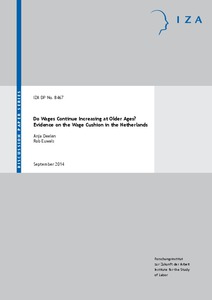Do wages continue increasing at older ages? Evidence on the wage cushion in the Netherlands
"In this study, we investigate the anatomy of older workers' wages. The central question is whether the wage cushion – i.e., the difference between actual wages and collectively agreed-upon (maximum) contractual wages – contributes to the fact that wages continue increasing at older ages....
| Main Authors: | , |
|---|---|
| Institution: | ETUI-European Trade Union Institute |
| Format: | TEXT |
| Language: | English |
| Published: |
Bonn
2014
IZA |
| Subjects: | |
| Online Access: | https://www.labourline.org/KENTIKA-19116217124919344999-Do-wages-continue-increasing-a.htm |
| Summary: | "In this study, we investigate the anatomy of older workers' wages. The central question is whether the wage cushion – i.e., the difference between actual wages and collectively agreed-upon (maximum) contractual wages – contributes to the fact that wages continue increasing at older ages. We follow the wages of individual workers in twenty-two sectors of industry in the Netherlands using administrative data for the period 2006–2010. In the public sector, we find no evidence of a wage cushion. Wage scale ceilings set in collective agreements are guiding for older workers' wages, and workers earning a contractual wage equal to a wage scale ceiling are not compensated with higher additional wages. In the private sector, we do find evidence of a wage cushion. Wage scale ceilings are less restrictive and workers earning a contractual wage exceeding the highest wage scale ceiling experience higher contractual wage growth. The private sector wage cushion enhances wage differentiation and allows for wages that continue increasing at older ages." |
|---|---|
| Physical Description: | 39 p. Digital |

